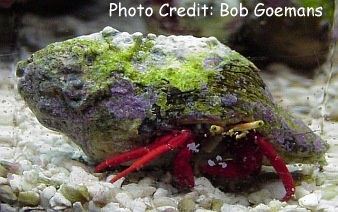
By Bob Goemans

Likely Reef Tank Suitable
Likely Fish-Only Tank Suitable
Range: Western Atlantic Ocean: Florida, Bahamas, Gulf of Mexico, Caribbean, and West Indies.
Natural Environment: Inhabits various reef areas and seen at depths between 25 to 100 feet (8 - 30 m).
General Husbandry: Has a bright red body and yellow eyestalks and also seems to like coralline algae, but does not stay in one place long enough to do much harm. What small damage is done is usually re-grown within a couple of weeks.
Also a good bottom scavenger, especially in reef aquariums. However, some seem to dwell more on rocks where picking at algae appears easier to get at.
Does not seem to harm coral polyps.
Stocking level recommendations vary greatly for these little janitors/scavengers, e.g., from 1 to 10 per gallon for reef aquariums. Yet one should relate their need to the condition of the aquarium, as very well maintained systems need only a few in the entire system. Overcrowded and/or overstocked systems no doubt need higher quantities. And new systems probably need none, as hermit nutritional needs will not be met until the aquarium ages somewhat.
If the supply of algae is limited, an algae wafer or feeder block may help supplement their diet. They also feed on any uneaten foods that fall to the aquarium bottom, whether it's flake, frozen, or live.
Keep in mind they do not have a shell of their own and therefore seek suitable size empty shells for protection, usually empty snail shells. The tip of their abdomen is then backed into the columella of the empty shell, calling it home. When danger exists, they retract further into the shell, disappearing from view. As they grow larger via the molting process in the wild, they must seek other slightly larger empty shells. Its this process of living in someone else's shell that has led to their common name 'hermit,' i.e., a hermit living alone.
It's advisable to keep an assortment of different size empty snail shells in the aquarium when maintaining this species (or any hermit), as they are very fussy about the space they have inside their selected shell and are always looking for something better/slightly roomier! In fact, they often enter into battles with other hermits for their shells, with the loser either highly damaged or dead. They may also sometimes pick on live snails, however it is thought they are seeking the shell and not attacking the snail itself.
Keep in mind they cannot tolerate copper treatments, therefore if they are in the same aquarium where fish need to be medicated with copper, they must be removed.
Taxonomy:
Kingdom: Animalia
Phylum: Arthropoda
Class: Malacostraca
Subclass: Eumalacostraca
Order: Decapoda
Superfamily: Paguroidea
Family: Diogenidae
Genus: Paguristes
FYI: May be more nocturnal when first introduced.
Not fussy about water quality.
Experience Level: Beginner
Diet: Omnivore
Temperament: Peaceful
Aquarium Environment: Reef or fish-only aquarium
Coral Safe: Yes
Fish Safe: Yes
Invertebrate Safe: Yes
Temperature Range: 68 - 81°F (20 - 27°C)
